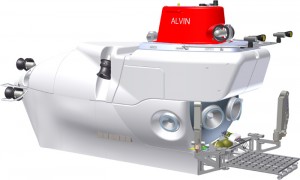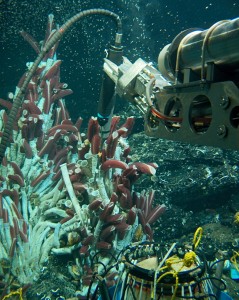20 December 2010
New cockpit for Alvin, the famous deep sea diver!
Posted by mohi

The new design of the Alvin, with more windows and a stronger hull. The new vessel will allow scientists to travel to 6,500 meters below the sea surface, 2,000 meters deeper than ever explored. Artist's rendition by Megan Carroll, WHOI
Between sessions last week, I hope you visited the exhibition hall one last time. Past the jewelery stands selling fossils and geodes and booths selling maps and drilling equipment, you may have spotted a minor celebrity–a little machine famous for great science.
At their booth, members of the Woods Hole Oceanographic Institution (WHOI) proudly displayed a mock up of the new crew cabin for the Alvin–a little submarine of large reputation. First built in 1964, this deep-ocean research submersible helped recover a hydrogen bomb lost by a US bomber off the coast of Spain in 1966, discovered life around deep hydrothermal vents off the Galapagos Islands in 1977, and was the first vessel to visit the Titanic in 1986. Since its first dive in 1965, Alvin, owned by the U.S. Navy and operated by WHOI, has made nearly 4,500 dives. Roughly 14,000 scientists, engineers and observers have been aboard this little sub that could.
The mock-up on display in the exhibit hall is a model of the Alvin’s new “cockpit” or crew area. It is part of the latest $40 million dollar retrofit, which features a shiny new $10-million-dollar titanium hull. With a stronger hull and new batteries, Alvin’s new incarnation will reach as deep as 6,500 meters, 2000 meters beyond its current capacity. Its new deeper-diving capabilities will let Alvin and crew explore little-known reaches of the ocean.
The new cabin will have five windows, up from three, improving visibility and navigability for the crew. Designers built the cabin mock-up so they could test where they should place instruments, before working on the actual vessel.
Up until a few weeks ago, Alvin was still diving. Now it is out of the water, at WHOI in Massachusetts. The redesign should be finished in 2015. In its 46-year history, Alvin has been remodeled many times. No part today is from the original 1964 vessel. Nonetheless, with its history of discovery, researchers expect many more years of exciting
discoveries with Alvin.
Visit WHOI’s website to tour Alvin virtually, learn about its important discoveries, and see what it is like to be an Alvin pilot.
–Danielle Venton is a graduate student at the UC Santa Cruz science writing program.











 GeoSpace is a blog on Earth and space science, managed by AGU’s Public Information staff. The blog features posts by AGU writers and guest contributors on all sorts of relevant science topics, but with a focus on new research and geo and space sciences-related stories that are currently in the news.
GeoSpace is a blog on Earth and space science, managed by AGU’s Public Information staff. The blog features posts by AGU writers and guest contributors on all sorts of relevant science topics, but with a focus on new research and geo and space sciences-related stories that are currently in the news.
Nice to have news from ALVIN. I got involved in follow up its deep exploration since the discovery of the hydrothermal vents on the Galapagos rift in 1977 and National Geographic published an interesting article on that.